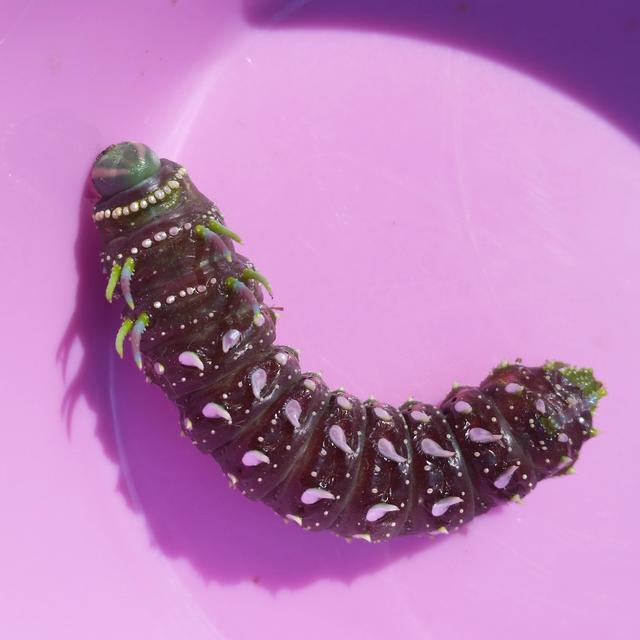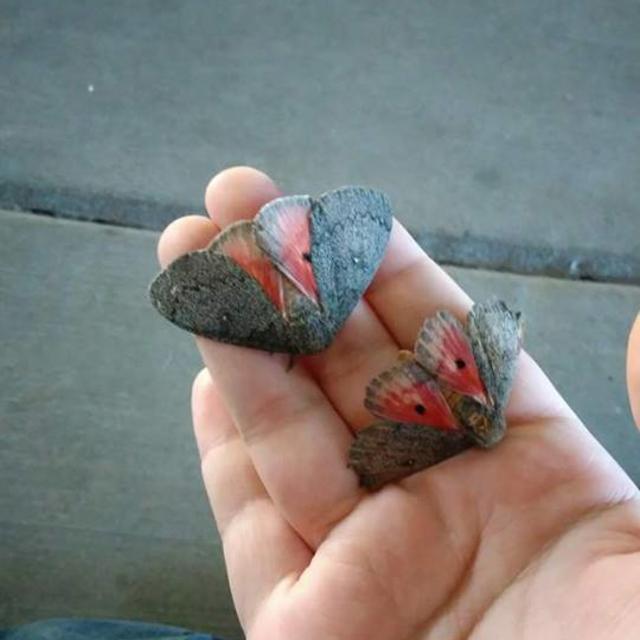Hubbard's Small Silkmoth
Sphingicampa hubbardi (Dyar, 1903)
Family: Saturniidae
Subfamily: Ceratocampinae
Identification: Females are larger than males; males are slightly darker. Upperside of forewing is dark gray with gray scalloped median and submedian lines that are obscured against the background. Upperside of hindwing is gray with red at the base which may spread over the whole wing. Forewing has a small white cell spot, hindwing has a larger black spot.
Wing Span: 2 3/16 - 3 inches (5.6 - 7.6 cm).
Life History: Adults emerge at dusk and mate later that night. The following evening the female lays her eggs. Young caterpillars perch on the undersides of petioles and feed on the leaf bases. Older caterpillars cut through petioles partway and bend down the leaves in order to feed on them. Caterpillars pupate and overwinter in shallow burrows in the ground.
Flight: Probably several broods in Texas from May-November, one brood in the rest of the range from June-September.
Caterpillar Hosts: Wright\'s acacia (Acacia wrightii), catclaw acacia (A. greggii), and honey mesquite (Prosopis glandulosa var. juliflora).
Adult Food: Adults do not feed.
Habitat: Oak woodland, shrubland, and thornscrub.
Range: Patchy distribution from central Texas west through southern New Mexico and Arizona to southeastern California; south to Veracruz, Mexico.
Conservation: Not usually required.
NCGR: G5 - Demonstrably secure globally, though it may be quite rare in parts of its range, especially at the periphery.
Management Needs: None reported.
Comments: NULL
Get your BAMONA Gear!
Please donate!
We depend on donations to keep Butterflies and Moths of North America freely available. We want to express our gratitude to all who showed their support by making a contribution this year. You can donate to support this project at any time.
Advertise with us!
Do you have a product or service that you think would interest BAMONA users? If you would like to advertise on this website, contact us by email, or use the contact form and select the "Advertising" category.
Verified Sightings
Displaying 1 - 24 of 81 verified sightings

Observation date: Sep 10, 2013
Submitted by: kontagion
Region: Pima County, Arizona, United States
Verified by: jwileyrains
Verified date: Oct 19, 2023

Observation date: Jul 17, 2022
Submitted by: J_Martineau
Region: Santa Cruz County, Arizona, United States
Verified by: J_Martineau
Verified date: Dec 08, 2022

Observation date: Sep 18, 2021
Submitted by: Andreacola
Region: Pima County, Arizona, United States
Verified by: kellyrichers
Verified date: Sep 26, 2022

Observation date: Sep 18, 2021
Submitted by: Andreacola
Region: Pima County, Arizona, United States
Verified by: kellyrichers
Verified date: Sep 26, 2022

Observation date: Sep 02, 2022
Submitted by: k.smith
Region: Maricopa County, Arizona, United States
Verified by: John Saba
Verified date: Sep 03, 2022

Observation date: Sep 19, 2019
Submitted by: Lois'Pets
Region: Cochise County, Arizona, United States
Verified by: jwileyrains
Verified date: Feb 07, 2022

Observation date: Aug 12, 2016
Submitted by: BliggityBlop
Region: Nebraska, United States
Verified by: jwileyrains
Verified date: Feb 03, 2022

Observation date: Oct 05, 2016
Submitted by: Djnorrisnaz
Region: Gila County, Arizona, United States
Verified by: jwileyrains
Verified date: Feb 02, 2022

Observation date: Sep 10, 2016
Submitted by: selaineh
Region: Pima County, Arizona, United States
Verified by: jwileyrains
Verified date: Feb 02, 2022

Observation date: Sep 03, 2016
Submitted by: angiem764
Region: Pima County, Arizona, United States
Verified by: jwileyrains
Verified date: Feb 02, 2022

Observation date: Jul 29, 2021
Submitted by: J_Martineau
Region: Santa Cruz County, Arizona, United States
Verified by: J_Martineau
Verified date: Dec 17, 2021

Observation date: Oct 18, 2021
Submitted by: kttaylor27
Region: Pima County, Arizona, United States
Verified by: John Saba
Verified date: Oct 18, 2021

Observation date: Sep 27, 2021
Submitted by: Nelia
Region: Pima County, Arizona, United States
Verified by: John Saba
Verified date: Oct 16, 2021

Observation date: Sep 25, 2021
Submitted by: doug9f
Region: Pima County, Arizona, United States
Verified by: John Saba
Verified date: Oct 16, 2021

Observation date: Oct 25, 2020
Submitted by: z0yk0t
Region: Pima County, Arizona, United States
Verified by: John Saba
Verified date: Mar 11, 2021

Observation date: Aug 04, 2019
Submitted by: Vestasflame
Region: Gila County, Arizona, United States
Verified by: kellyrichers
Verified date: Dec 09, 2020

Observation date: Nov 14, 2020
Submitted by: squidpdx
Region: Pima County, Arizona, United States
Verified by: kellyrichers
Verified date: Nov 20, 2020

Observation date: Jun 08, 2019
Submitted by: Solenodon
Region: Pima County, Arizona, United States
Verified by: John Saba
Verified date: Jun 12, 2019

Observation date: Jul 02, 2017
Submitted by: drvmd
Region: Yavapai County, Arizona, United States
Verified by: kellyrichers
Verified date: Aug 24, 2017

Observation date: Aug 16, 2017
Submitted by: Sam Rodd
Region: Pima County, Arizona, United States
Verified by: kellyrichers
Verified date: Aug 24, 2017

Observation date: Aug 18, 2017
Submitted by: azrhino
Region: Pima County, Arizona, United States
Verified by: John Saba
Verified date: Aug 19, 2017

Observation date: Aug 16, 2017
Submitted by: April80
Region: Pima County, Arizona, United States
Verified by: John Saba
Verified date: Aug 19, 2017

Observation date: Aug 13, 2017
Submitted by: Watcher1
Region: Pima County, Arizona, United States
Verified by: John Saba
Verified date: Aug 16, 2017

Observation date: Sep 09, 2016
Submitted by: rdhealy1951@aol.com
Region: Yavapai County, Arizona, United States
Verified by: kellyrichers
Verified date: Oct 12, 2016
- 1 of 4
- next ›



